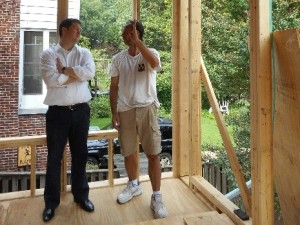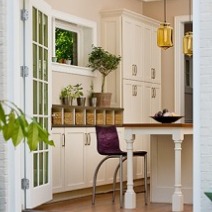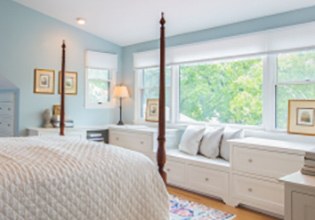Rear Tudor Home Addition in DC
In 2013, Wentworth was contacted by a family in Northwest, Washington, DC seeking to renovate their kitchen and build a small two-floor rear addition on top of their basement level garage. Their 1920s home was a Tudor-style house.
The couple’s young son needed a play area on the first floor, so the clients brought up the idea of converting an underused covered porch into a sunroom/playroom that would evolve into an adult space over time. The existing house had too few windows at the rear, and the clients wanted more natural light and to open up views into their backyard from their kitchen and new addition. They liked the Tudor Style architecture of their home and asked our design team to carry that aesthetic into the new addition.
Two-Story Addition for Sunroom, Walk-In Closet/Dressing Room & Full Kitchen Remodel
Although the house is well laid out, it lacked a suitable master bedroom walk-in closet on the second floor. The two-floor addition easily accommodates a new closet and dressing room/office. Back on the first floor, the clients expressed their ideas for a new kitchen that was efficient and easy-to-clean, with maximum storage space and slightly more open to the adjacent dining room. They also wanted a small breakfast bar area where their son could sit while they prepared meals in the kitchen.

Exterior Design Options for Rear Addition
Responding to the clients’ desire to keep their new addition in sync with the Tudor style, our design team prepared three options (seen below), each with a Tudor style influence but slightly different take on the exterior façade. The homeowners selected option #2, which is what we built. The design options had roof forms that varied from hip to gable to flat. Our designers recommended gray textured roof shingles to resemble the home’s original slate roof which blends perfectly. And each exterior façade design option offered variations on the Tudor style half-timber decorative treatment found on the front of their home.

Kitchen Design
The homeowners felt their old kitchen did not make the best use of available space and was dark and poorly laid out. After studying many options, we evolved a new design that placed the appliances in ideal locations and opened up the wall between the dining room and kitchen. The wider wall opening accommodates a peninsula with cabinets and a custom walnut countertop. The old kitchen window configuration included glass block at the south side and a narrow horizontal window looking into the backyard. Our design team improved this with new and larger corner windows that capture morning and southern sunlight and also provide a view from the sink area. Every design detail was discussed with the homeowners:
- Cabinet layout and accessories
- Paint colors
- Countertop materials
- Backsplash tile
The functionality and aesthetics were fully explored. We learned how they cooked in their kitchen, what type of cabinets they preferred in terms of aesthetics (flat recessed door panels, painted with full-overlay construction) and function (drawers, and a mix of pull-out shelves and fixed shelves). Thoughtful design helped them achieve a more organized life.
We recommended kitchen appliances based on earlier conversations with the homeowners. And as a cost-saving effort, they had us plan the cabinets to accommodate a future larger refrigerator while in the meantime reusing their old smaller refrigerator.
Lighting design incorporated recessed lighting as well as pendant lighting with exterior sconces.
Demolition & Installation of Addition Framing

Upon receiving our DC building permit, we started the on-site prep and demolition. The clients wanted to salvage the roof slates from their existing porch, which required Wentworth’s carpenters to carefully remove them. The family also wanted to preserve the original pegged-oak flooring in their dining room, (which was replicated in the new kitchen and sunroom) which required covering in sheets of protective material before demolition began.
The next step is roofing and sheathing. Once the roof is in place, we will move forward with enclosing the space and finishing the interior.
One of the advantages of design-build is the close level of communication between architects and craftsmen. Architects visit our project sites frequently to stay informed of job progress and collaborate with our field staff to solve problems that may arise.
View our portfolio to see pictures of this addition in NW Washington, DC!







